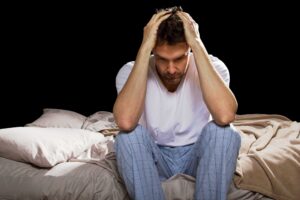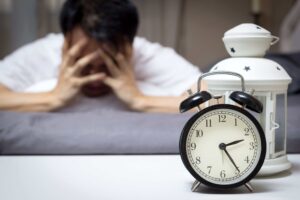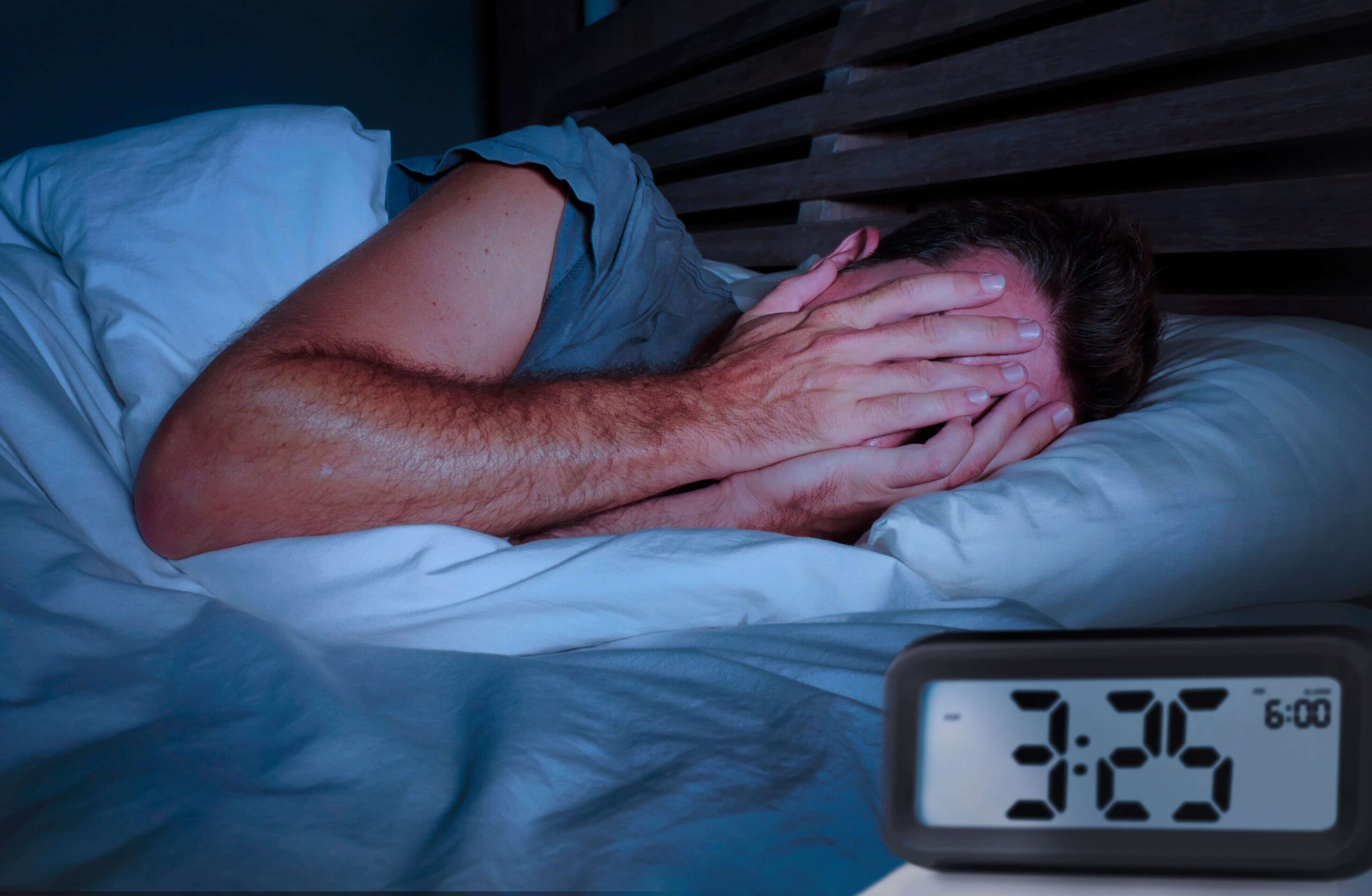It’s not unusual to struggle with getting a good night’s sleep occasionally. Whether it’s due to stress, a jam-packed work or social schedule, environmental considerations like room temperature or noise, our sleeping position, or simply an inability to tame racing thoughts, many of us toss and turn some nights. And while no one particularly enjoys feeling groggy in the morning, most of us can soldier on with the help of a cup of coffee and a hearty breakfast.
Sleep disorders are less common than the occasional sleepless night but carry significant risks to the sufferer’s physical and mental health. While millions of people complain about not getting enough sleep, about 70 million have a potentially serious sleep disorder stemming from one of the 80 different types of the condition. According to the American Psychiatric Association, sleep disorders (also known as sleep-wake disorders) “involve problems with the quality, timing, and amount of sleep, which result in daytime distress and impairment in functioning.”
The importance of sleep is something a lot of us overlook or take for granted, needlessly going without for any number of fixable reasons. Today, we’ll explore sleep disorders further, closely examining the most frequently occurring types, what causes them, and how sufferers can treat them to find relief.
How Much Sleep Do We Really Need?
Before we talk about sleep disorders and the types of conditions that harm our sleep, we thought it might be helpful to share what experts say about how much sleep is necessary. You probably won’t be surprised to hear this, but the recommended hours of sleep vary depending on age.
As you might expect, babies and adolescents need more nightly sleep to support growth and development. Per the National Sleep Foundation guidelines, healthy adults should receive between 7 and 9 hours of sleep each night. Those recommendations range from 14 to 17 hours for newborns and 8 to 10 hours for teenagers. Interestingly, experts believe adults aged 65 and older should receive 7 to 8 hours of sleep, with 9 and 10 hours falling into the “not recommended” category.
Of course, those guidelines are just that, and knowing how much sleep is needed can be subjective. Here are the questions the National Sleep Foundation suggests asking yourself to assess your own sleep needs:
- Are you productive, healthy, and happy on seven hours of sleep? Or have you noticed that you require more sleep to get into high gear?
- Do you have coexisting health issues? Are you at higher risk for any disease?
- Do you have a high level of daily energy expenditure? Do you frequently play sports or work in a labor-intensive job?
- Do your daily activities require alertness to do them safely? Do you drive every day or operate heavy machinery? Do you ever feel sleepy when doing these activities?
- Are you experiencing or do you have a history of sleeping problems?
- Do you depend on caffeine to get you through the day?
- When you have an open schedule, do you sleep more than you do on a typical workday?
Why Do We Need Sleep?
 From childhood, our parents or others have encouraged us to get enough sleep, but most people can’t explain why we need a certain amount of restful sleep. The reality is that sleep impacts nearly every part of the body in some form or fashion. As soon as we fall asleep, thousands of neurons in the brain send signals throughout the body, transitioning from a waking state to a sleeping state as the body begins its repair and maintenance processes.
From childhood, our parents or others have encouraged us to get enough sleep, but most people can’t explain why we need a certain amount of restful sleep. The reality is that sleep impacts nearly every part of the body in some form or fashion. As soon as we fall asleep, thousands of neurons in the brain send signals throughout the body, transitioning from a waking state to a sleeping state as the body begins its repair and maintenance processes.
Sleep restores energy levels, which dramatically affects the mood we’re in when we awake. Additionally, our heart rate slows and blood pressure decreases during sleep, which enables the body’s heart and vascular system to receive much-needed rest. By not getting quality sleep, we increase the risk of developing heart disease and having a heart attack or heart failure.
Because sleep is linked to the hormone insulin, failing to get an adequate amount can up one’s chances of developing Type 2 diabetes. The National Sleep Foundation writes that the reason for this is that “the body’s resistance to insulin increases because cells are not able to use insulin appropriately, which leads to too much sugar in the bloodstream.”
One of the more underrated aspects of sleep is its influence on our immune system. During sleep, the body produces proteins called cytokines that aid the immune system in staving off infections. In response, people who don’t get enough sleep may suffer from colds and other illnesses more often than those with healthy sleep habits.
Other noteworthy facets of daily living impacted by sleep include the capacity to manage stress effectively, improved mental function, reduced risk of injury during athletic endeavors, and the propensity to maintain a healthy weight.
Here’s what the National Library of Medicine had to say about the health effects of not getting enough sleep: “Sleep is important for overall health. When you don’t get enough sleep (sleep deprivation), it does more than just make you feel tired. It can affect your performance, including your ability to think clearly, react quickly, and form memories. This may cause you to make bad decisions and take more risks. People with sleep deprivation are more likely to get into accidents.”
Types of Sleep Disorders
As mentioned, there are some 80 different types of sleep disorders; however, a handful stands out from the rest in terms of how often they occur.
Perhaps the most common sleep disorder is insomnia, a condition referring to one’s failure to fall asleep in a reasonable amount of time or stay asleep for prolonged periods. Living with insomnia can have both a mental and physical toll on the body, with sufferers experiencing depression, difficulty concentrating, irritability, weight gain, and impaired work or school performance. Sadly, studies show that up to half of all American adults will experience bouts of insomnia at some point in their lives.
It’s important to clarify that there are three different types of insomnia, as each can affect you differently. Chronic insomnia takes place on a regular basis, while intermittent insomnia comes and goes periodically. Similarly, transient insomnia is more temporary and lasts just a few nights.
Sleep apnea is another common type of sleep disorder that can stress the body significantly and put the person’s health at risk. Health experts explain sleep apnea causes an individual to pause their breathing while asleep. Because of those pauses, the body takes in less oxygen, and sufferers will repeatedly wake throughout the night, gasping for air.
As with insomnia, there are different types of sleep apnea: obstructive sleep apnea, when the airway space is either blocked or too narrow, stopping airflow; and central sleep apnea, where there is a disconnect between the brain and the muscles responsible for breathing. Either type of sleep apnea endangers the person’s health.
The next type of sleep disorder, parasomnias, encompasses an entire class of conditions. Sleep disorders that fall under the parasomnia class are related to unusual behaviors, movements, or actions that occur while sleeping. Examples of parasomnias include sleepwalking, sleep talking, nightmares, bedwetting, and teeth grinding.
Another type, restless leg syndrome, is unique from other sleep disorders in that it can also occur during the day — though it does happen most often at night. With restless leg syndrome, the person wrestles with the need to move their legs. People also sometimes feel tingling in their legs, contributing to their inability to sleep soundly. Some research has found a link between restless leg syndrome, attention deficit hyperactivity disorder (ADHD), and Parkinson’s disease.
Narcolepsy is a sleep disorder where a person can experience abrupt “sleep attacks” or sudden bouts of fatigue. They can become exhausted and even fall asleep without warning. In some cases, narcolepsy can cause sleep paralysis and is associated with multiple sclerosis and other neurological disorders.
Symptoms of Sleep Disorders
 In continuing our exploration into the most commonly occurring sleep disorders, we wanted to dig deeper into the symptoms of those five different types.
In continuing our exploration into the most commonly occurring sleep disorders, we wanted to dig deeper into the symptoms of those five different types.
As we said earlier, insomnia is a widespread sleep disorder associated with frequent difficulty falling or staying asleep. However, certain specifics go into a proper insomnia diagnosis.
For example, someone who has difficulty falling asleep has what’s called “sleep onset insomnia,” while a person who struggles to stay asleep has “sleep maintenance insomnia.” With chronic insomnia, the National Sleep Foundation reports that “patients must experience symptoms at least three times per week for at least three months” to meet diagnostic criteria.
“Sleep onset and sleep maintenance problems have been documented across all age groups,” the National Sleep Foundation writes. “Periods of sleep latency (the amount of time it takes to fall asleep) or wakefulness during the night may constitute chronic insomnia if they exceed 20 minutes for children and young adults, or 30 minutes for adults.”
Intermittent insomnia and transient insomnia are similar to chronic insomnia, with the differences being the regularity of the episodes. Though these bouts of insomnia may come and go, health professionals should not ignore the potential gravity of the condition for the sufferer. This short-term insomnia may occur because of an underlying mental health disorder, medical condition, or substance abuse. In those cases, addressing the underlying issue can simultaneously alleviate the episodes of insomnia.
Typically speaking, a person with short-term insomnia will feel tired or general malaise while awake, along with sensations of irritability and aggression, and may be at an increased risk for accidents.
Unlike insomnia, which a person with the disorder easily recognizes, sleep apnea can go unnoticed unless brought to light by someone else. Whether a blocked airway or a cognitive misfire is causing sleep apnea, loud snoring, choking, or gasping may alert the sleeper’s partner of disrupted breathing.
In addition to drowsiness, a person with sleep apnea may suffer from headaches and a dry mouth when they first wake up. Common behavioral symptoms of sleep apnea may include limited focus, heightened frustrations, and abnormal breathing patterns while sleeping.
The next type of sleep disorder we’ll discuss is parasomnias, and, although it is sometimes the subject of jokes in television shows and movies, this sleep disorder can be dangerous or frightening. This catch-all term for “unusual behaviors that occur just before falling asleep, during sleep, or when waking up” includes actions like sleepwalking, sleep talking, night terrors, and sleep-related hallucinations.
The typical symptom in each of these parasomnias is that they all stray from what should be the norm for nighttime behaviors. Like with many other sleep disorders, these conditions can leave the person drowsy and irritable while awake — but some, like sleepwalking, also put the person at risk of physical harm.
Restless leg syndrome affects up to 10% of adult Americans, affecting more women than men. Although people of any age can suffer from restless leg syndrome, older adults tend to have the most severe symptoms. Although some may not recognize restless leg syndrome as a sleep disorder, sufferers can attest to the adverse effects of the condition on their own sleep and often that of their sleep partner.
Though describing the signs and symptoms of restless leg syndrome can be challenging, individuals may describe it as “aching throbbing, pulling, itching, crawling or creeping” sensations in the legs that intensify at night. To find relief, sufferers must move their legs, sometimes even pacing around the room, which interrupts their sleep and causes lethargy in the morning.
Lastly, there’s narcolepsy, which is markedly different from some other sleep disorders in that someone with narcolepsy can fall asleep without warning at any time. Excessive daytime sleepiness is the primary symptom of narcolepsy, though other symptoms include sleep paralysis, sleep-related hallucinations, and disrupted sleep patterns.
One of the more unusual symptoms of narcolepsy is the introduction of automatic behaviors, which is when someone focuses so hard on avoiding sleep that they do things without reasoning. An excellent example is someone believing they are writing coherent sentences but scrawling gibberish without recognizing what they’re doing.
Causes of Sleep Disorders
Many of the most common sleep disorders stem from comorbid diseases. The National Library of Medicine cites conditions like heart disease, lung disease, nerve disorders, and pain as common causes of different sleep disorders.
Additionally, mental illnesses like depression and anxiety, along with certain medications and genetics, can increase one’s chances of developing a sleep disorder. Behavioral habits like drinking too much caffeine (especially late at night) or alcohol and working abnormal or irregular schedules may also be contributors.
While we may be able to curtail unhealthy habits that negatively impact our sleep, the one influence we can’t change is time. Many people sleep less or experience poorer quality sleep as they age.
Treatment for Sleep Disorders
Management and treatment of sleep disorders can vary by condition, but there are some practical steps anyone struggling to achieve healthy sleep can take to help their cause. Healthcare providers and sleep experts recommend developing a regular sleep schedule devoid of wild swings when you go to bed and wake up. Regular exercise, minimizing ambient noise and light, and maintaining the temperature in the room can all help establish healthy sleep patterns. Some sleep experts also suggest undergoing cognitive behavioral therapy (CBT).
Additionally, some people with sleep disorders find medication helpful. For example, melatonin, zolpidem, and zaleplon are some of the most popular sleep aids, especially for insomnia. Prescribed medications, like gabapentin for restless leg syndrome and modafinil for narcolepsy, may improve symptoms of these sleep disorders.
The most conventional method of treating sleep apnea is continuous positive airway pressure (CPAP). During sleep, the patient wears a mask connected to a machine that provides constant airflow to keep airway passages open and prevent apnea and snoring. Some find the CPAP machine facemask uncomfortable or cumbersome, which can cause the person to abandon its use. Different types of masks are available, so it’s in your best interest to consult your doctor until you find one that works for you.
Rising Phoenix Wellness Services Can Help Address Underlying Causes
Because there are so many different types of sleep disorders, each with its nuances, it’s essential that anyone experiencing one of these conditions speak with a qualified healthcare provider. If a mental health problem or substance use disorder is at the root of the sleep disorder, Rising Phoenix Wellness Services is here to help.
Our outpatient and intensive outpatient programs are holistic in nature, combining the best traditional and non-traditional evidence-based therapies to treat the whole person — mind, body, and spirit. The compassionate, highly trained staff at Rising Phoenix Wellness is committed to restoring physical and mental well-being to each client so that each person can achieve the quality of life they deserve.
If you’re interested in learning more about how we treat sleep disorders, substance use disorders, mental health disorders, or a combination of issues, send us a message today for admission information and a confidential assessment.

